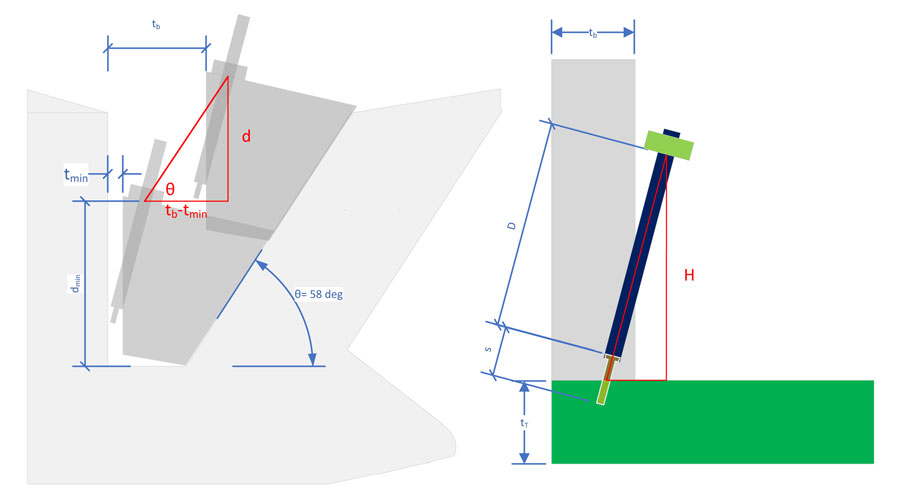The Pocket-Hole Jig 720 uses Kreg Automaxx™ to enable one-motion clamping by simultaneously clamping your workpiece and automatically adjusting to the exact thickness of your material (from 1/2″ to 1 1/2″). GripMaxx™ anti-slip holds the project piece secure. The manual doesn’t address how to pick the right screw length or how to set the stop outside of several settings. This isn’t good enough for me and I need to do some measurements and geometry to figure out the exact length.
I like to be exact. The standard angle of Kreg pocket holes is 15 degrees, the whole assembly approaches the workpiece at a fixed angle to place the start of the hole in the right distance from the bottom of the board.
If I measure this in Photoshop (after skewing to correct for image distortion), I get an angle of 58.1 degrees.
If I measure it direct (after accounting for the angle of the desktop by zeroing out the surface), then I get 57 degrees.
The most accurate method is to measure.
So I took these measurements and came out with.
| s | d | |
|---|---|---|
| high point (mm) | 43.9 | 54 |
| low | 10.1 | 0 |
| accuracy | 0.1 | 0.1 |
| Δ | 33.8 | 54 |
| θ | 57.95648317 |
So I have two measurements, 57.95648317 degrees or 58 degrees or 57 degrees. I’m going to go with what I measured and refine as I measure real cuts.
The geometry of this is cool: as the timber gets wider, the drill bit translates up at double the degree of the pilot hole to ensure the tip of the drill hits the center of the board. The angle of the jig and wedge is twice the angle of the screw since the drill bit angle has to be half the wedge angle if it is to intersect the base at half the width of the board. It’s designed to bring the tip of the bit out in the center of the edge of the piece being drilled and automatically compensates for the timber thickness. Because of this, if the black slope is 58° from horizontal then it is 32° off vertical and the actual angle of the pocket hole is 16°.
Armed with this angle, I have to do some geometry. Given \(t_{\text{min}}\), \(t_b\) the thickness of the board for pocket holes, \(t_T\) the thickness of the board you are screwing into, \(\theta\), the angle of the jig, and \(s\), the length of the shaft of the screw. We want to find \(D\) the length of the shaft of the pilot screw.
From this I can calculate:
$$D = \frac{H}{\cos(15 \deg)} – \frac{s}{2} \text{ or } D = \frac{H}{\cos(\theta/2)} – \frac{s}{2} $$
$$d = \tan(\theta) \, \left( t_b -t_{ \text{min} } \right) \text{ where } \theta = 58 \deg $$
Putting these together from \(H=d_{\text{min}} + d\) we have:
$$ D = \frac{ d_{ \text{min}} + \tan(\theta) \, \left( t_b -t_{ \text{min} } \right) }{\cos(\theta/2)} – \frac{s}{2} $$
I hope to use this some day to make an online calculator.





Sweet…this seems more like you are machine shop, machining tight tolerances into metal parts rather than building picture frames, cabinets, and bird houses… Never saw this on the New Yankee Workshop…